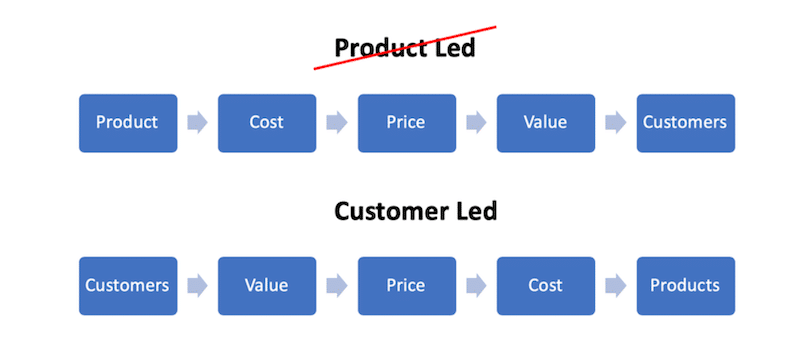Will Value based pricing save you from red ocean death?
If you know me personally, you might think of me as a runner. I mean a serious runner who finished more than thirty marathons on all seven continents. You might not realize I’m also a great surfer! No, not the kind who will wake up at 5am to brave the cold Pacific Ocean waters.
I’m a red ocean surfer!
Let me explain… I’ve been surfing the “commoditization” wave in red oceans for the past fifteen years at companies like Avid and Plantronics. I can tell you it’s not my definition of “Fun”! A red ocean market exists when you and your competitors are engaged in cutthroat fights in an established category. It often turns bloody (hence the red ocean term, I suppose!). Even if you are an adept of value-based pricing, it becomes complicated to stand out in a red ocean market. Commoditization happens, and you get to the point of losing your uniqueness. Your product or solution then has the same, or even lower, perceived value as your main competitors.
Sadly, we have witnessed a growth of commoditization in many industries over the past few years. It also feels like the COVID-19 pandemic has accelerated the formation of more new red ocean markets. With the dominance of online marketplaces driven by Amazon or Alibaba, customers are exposed to your next best competitive alternatives, and prices spiral down under pressure.
So, how can you survive in such red oceans? Is there a way out? How do you avoid getting there in the first place? All fascinating questions I’ve been pondering over the years. With experience, I have learned a few principles that kept me out of trouble, here they are:
Beware the destructive forces of the red ocean

One you find yourself in a real red ocean, there’s unfortunately very little you can do to get out of it. Unless you fundamentally shift gear and completely rethink your strategy or business model. The conditions of a red ocean are created by your competition and how smart they are about establishing value and prices. If your most aggressive competitors simply have a different model for making a profit, think twice before you pull the trigger on a price war.
I’ve seen this phenomenon more than once in the headphone industry:
You partner with an OEM (Original Equipment Manufacturer) to manufacture your products. Soon enough, the OEM is becoming really good at what they’re doing, and they launch their own solution to compete with yours. Their distribution model is light, they mostly sell on marketplaces like Alibaba and Amazon and can afford thin margins. You’re stuck with an omnichannel and multi-tier distribution strategy, including brick-and-mortar retailers. You just cannot afford to be as aggressive on pricing. If you don’t have any significant differentiator in your customer’s mind, you’re dead in the water!
Value-based pricing might save you

A value-based pricing strategy can help if it’s not too late. For more on value-based pricing virtues, see my other post on the topic: “Strategic Pricing: Your Most Powerful Profit Optimizer“. If you’re not familiar with it, value-based pricing is about understanding how products generate customers‘ value. A practical way to look at it is to reverse the traditional way companies go about pricing. Instead of starting with the product, you start with the customer. In essence, it is customer–based pricing.
Yet, you should do it right!
Value-based pricing works best when you can associate a dollar amount to your differentiating benefits. With this in mind, if you can explain how much better, faster, stronger your product is, it will translate well into your distinct value. On the other hand, softer brand attributes are much harder to compete with, unless you’re one of the giga-brands like Apple. So you’d better compete with hard vs. soft benefits.
What you really need is a paradigm shift

More often, though, value-based pricing is just not enough to get out of this vicious circle. There is simply too much pressure on profitability in your highly competitive and slower-growth environment. If you want to avoid a race to the bottom, you need a pivot strategy. The principle here is to identify your own “blue ocean” or viable market and redirect your efforts there. Today’s COVID-19 pandemic is giving us ample illustrations of such pivots. Restaurants shift into catering and meal home delivery, while industrial suppliers now manufacture artificial respirators or masks. Educators and coaches are moving their practice online. The list is long.
To properly pivot, though, you need to be crystal clear on your own core competencies. For more on this topic, read my other post, “Wanted: Core Competencies to Boost Success“. It is also crucial to keep a particularly strong pulse on how your customer problems are shifting: what are the unmet requirements that neither you nor your competitors currently address? More than ever, you need to reach out, talk to your customers, understand their big problems. The insights you’ll generate can then be mapped to your core competencies to identify your new uniqueness.
But, what if you simply cannot identify any relevant match between your customers’ unmet wants and your own core competencies? Should you acquire new skills? Probably, but it will likely take some time and is often a longer-term strategy.
A safer and more actionable bet in short to mid-term is to bring your own existing competencies to adjacent markets that are not as mature as your current ones.
Again, COVID-19 is proving to reveal such paradigm shift: many businesses and sometimes entire industries will die, but new opportunities also arise.
In Conclusion
Moving out of a red ocean requires a significant leap of faith and a fundamental transformation of how you see the market, how you operate, and your own leadership. Management experts like Chan Kim and Renée Mauborgne have paved the way for years on the exact steps you can follow to shift to a Blue Ocean strategy. In case you haven’t read their books, I invite you to do so: Blue Ocean Strategy and Blue Ocean Shift.
At any rate, the fundamental principles I keep highlighting on this blog hold true, and to thrive you need to:
- deeply understand your customers and markets,
- know your core competencies,
- have a credible and robust destination,
- be ready to pivot and let your egos aside.
That’s the good news! With the right approach, you can shift away from red oceans and move to gentler seas. Just don’t believe pricing (even value-based) will solve it all though!
I’m genuinely interested in getting your feedback on this topic! How successful have you been with identifying and executing your own blue ocean strategy? Which other considerations worked for you? Just comment on this blog or drop me a note on The Product Sherpa site!
Also, if you want to fast-track your own pivot strategy, The Product Sherpa is here to help you. We offer custom makeover programs for you to practice your critical thinking and get results. You can drop us a note, or schedule a free exploratory call.
